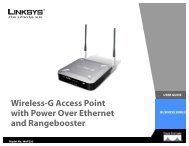Cisco Small Business RV 120W Wireless-N VPN Firewall ...
Cisco Small Business RV 120W Wireless-N VPN Firewall ...
Cisco Small Business RV 120W Wireless-N VPN Firewall ...
You also want an ePaper? Increase the reach of your titles
YUMPU automatically turns print PDFs into web optimized ePapers that Google loves.
Configuring NetworkingConfiguring IPv62Configuring Intra-Site Automatic Tunnel Addressing Protocol (ISATAP)TunnelsIntra-site automatic tunnel addressing protocol (ISATAP) is a method to transmitIPv6 packets between dual-stack nodes over an IPv4 network. The <strong>Cisco</strong><strong>RV</strong><strong>120W</strong> is one endpoint (a node) for the tunnel. You must also set a local endpoint,as well as the ISATAP Subnet Prefix that defines the logical ISATAP subnet toconfigure a tunnel.To add an ISATAP tunnel:STEP 1STEP 2STEP 3STEP 4STEP 5STEP 6STEP 7Choose Networking > IPv6 > Tunneling.In the ISATAP Tunnel Table, click Add.Enter the tunnel name.Choose the local endpoint address, or the endpoint address for the tunnel thatstarts with the <strong>Cisco</strong> <strong>RV</strong><strong>120W</strong>. The endpoint can be the LAN interface (if the LANis configured as an IPv4 network), or another LAN IPv4 address.If you chose Other IP in Step 4, enter the IPv4 address of the endpoint.Enter the ISATAP subnet prefix. This is the 64-bit subnet prefix that is assigned tothe logical ISATAP subnet for this intranet. This can be obtained from your ISP orinternet registry, or derived from RFC 4193.Click Save.To modify the settings of an ISATAP tunnel:STEP 1STEP 2STEP 3Choose Networking > IPv6 > Tunneling.Check the check boxes for the tunnels you want to modify.Click Edit, make the changes, and click Save.<strong>Cisco</strong> <strong>RV</strong><strong>120W</strong> Administration Guide 48
















